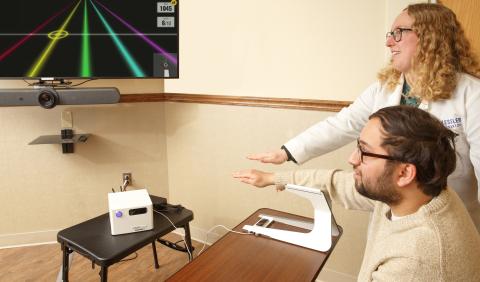Enhancing Recovery: New Virtual Reality Tools Deliver Traumatic Brain Injury Rehabilitation Options
Explore methods for improved cognitive and physical outcomes
By Diana Jordan, Assistant Digital Media Editor, Media/Communications
After living through a major automobile accident, Jeff woke up the next day in the hospital unable to remember what he had for dinner the night before or what day of the week it was. While conversing with his brother, he struggled to respond with the correct words. Depending on the type of traumatic brain injury (TBI) he sustained, Jeff might regain his full mental capabilities. Or not. Without proper rehabilitation and care, individuals with TBI may continue to struggle with deficits in learning and memory.
Virtual reality (VR) has emerged as a pivotal tool in the rehabilitation process for individuals with traumatic brain injury. The Center for Traumatic Brain Injury Research at Kessler Foundation has been leveraging this cutting-edge technology to support individuals with TBI in regaining cognitive function and mobility, empowering them to achieve independence and enhance their quality of life.
According to the Brain Injury Association of America, more than 5.3 million individuals in the United States are living with a permanent brain injury-related disability and at least 2.8 million sustain TBI every year. Brain Injury Awareness Month, celebrated every March, presents an annual opportunity to recognize the causes of brain injury, promote prevention, and provide access to recovery resources.
Below are several VR devices actively integrated into a number of research studies conducted at the Foundation.
Exergame device with a participant.
Exercise Video Game (Exergame)
A research study compares the effectiveness of two programs: an exercise video game (Exergame) and home-based arm and hand exercise (HAHE) to improve daily functions in individuals with brain injury who have impaired use of their arms and hands. “Both programs are focused on functional tasks and daily activities,” said Peii Chen, PhD, senior research scientist in the Center for Stroke Rehabilitation Research. “Participants are randomized into either program, completing the assigned exercise for six weeks on their own with remote consultation from an occupational therapist.”
TBI can have a significant impact on vision, causing impaired visual attention (also known as visual neglect), even if there is no injury to the eye. Individuals may have difficulty reading, locating personal belongings, finding their way to destinations, and many other daily activities. This study involves an intensive, game-like rehabilitation program leveraging a combination of VR and eye-tracking technologies to implement an oculomotor exercise protocol based on smooth eye pursuit. Research participants also undergo functional and structural neuroimaging studies of the brain. The study results will help researchers understand how the brain handles spatial processing and visuals after a TBI.
MusicGlove
Individuals with TBI may experience muscle weakness, which affects the fine motor control of fingers and arms. In this study, researchers examine how brain stimulation can help improve hand dexterity in individuals with TBI. Participants in this study play a video game while wearing a hand glove on the affected hand. By demonstrating specific finger movements and grips, participants are able to play songs. “Our lab focuses on studying novel neural engineering methods – such as non-invasive brain stimulation and smart wearable sensors – for improving the motor rehabilitation in individuals with stroke and traumatic brain injury,” said Viram Shenoy Handiru, PhD, director of the Neuromuscular and Electrophysiology Laboratory at the Foundation.
C-MILL Augmented Reality Treadmill
After a TBI, individuals may have balance issues and difficulty walking. This research study utilizes a VR-based treadmill called C-MILL, which simulates walking conditions encountered in daily life. It is being used to help participants regain their ability to walk and balance. “Our mission is to develop and evaluate innovative, user-centered assistive and rehabilitation technology,” says Kiran Karunakaran, director of the Balance Assessment and Training Laboratory at the Foundation, “as well as develop technology-based quantitative assessments for gait and balance in people with mobility deficits.” Researchers are also examining changes in thinking ability and brain activity as a result of this training.
Learn more about our ongoing research on traumatic brain injury or consider taking an active role by volunteering to participate.

